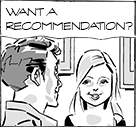Page 45 Review by Stephen
"Remember, the key to creativity is always observing the world in different ways."
An exceptional guide to how comics and indeed the eye works, this can, should you fancy, also kick-start your own creativity and, as important as anything else, catalyse some creative thinking.
For this is no mere "how to draw" but more - like Scott McCloud's UNDERSTANDING COMICS and MAKING COMICS and so many other books in Page 45's Creating Comics Section - a manual that delves deeply into the mechanics of how this unique medium of sequential-art narrative actually operates. There will be plenty of illustrated advice on lettering, colouring, cover design and all visual elements which can be incorporated into comics, but more than anything else, as Tim Pilcher emphasises, this is about telling stories, and it comes from one of the medium's most respected storytellers.
You might have heard of Dave Gibbons: WATCHMEN etc. Yes, he has fair few comics under his belt. Largely, then, he draws on these fifty years of experience and his own body of work to illustrate the variety and complexity of techniques, many of which may never have occurred to you, which he and Tim Pilcher examine together.
However, Gibbons has his own heroes including co-collaborators like Frank Miller, and their contributions are also called upon in interludes. Of GIVE ME LIBERTY, Gibbons recalls:
"I also suggested a character who saw crime as a disease, and [Frank's] response was, "Yeah, but what would be better is a character who sees disease as a crime". That was the Surgeon General."
His medical approach was quite militant.
It's a huge book of enormous scope and depth, and I'm a slow reader (and writer) so please forgive me if I leave you largely to absorb the book itself, by yourself, rather than simply regurgitate it on this keyboard. I'd be wasting both your time and mine.
However, I found the pages on 'Hot Spots' fascinating, and this is what I meant by "how the eye works".
"Basic art theory states that within a given area, there are certain points, or 'hot spots', that the eye is attracted to, so it makes sense that this is where you should place what it is you really want people to look at."
He elaborates and illustrates, obviously. No, this art isn't one that you'd necessarily identify upon reading a comic. Ideally you should be immersed. I cannot abide a comic whose script I can hear being typed and, as Edward Albee once wrote, "Symbols should never be cymbals". The analyses do remain riveting, though.
Landscapes, vehicles, character design, grid structure, panel designs, pacing and movement, thumbnails, pencils, inks (manual and digital), the practicalities or printing, lettering, dead space, colouring, covers and even back-cover design are all delved into - along with the spine! - before daily exercises are suggested including 'mind maps'.
I can show you how to operate a till if you like, but for this infinitely higher skill set I hand you over to Mssrs Gibbons and Pilcher. Avoid repetition and keep it kinetic even in conversations, folks!

